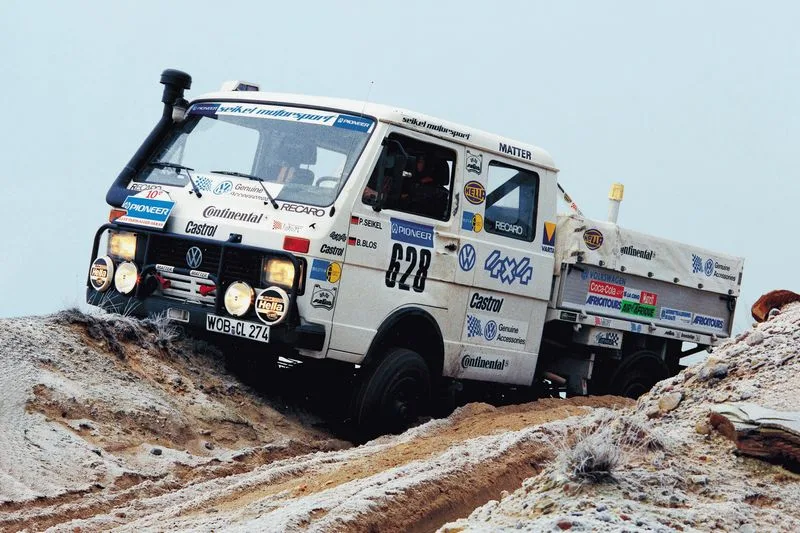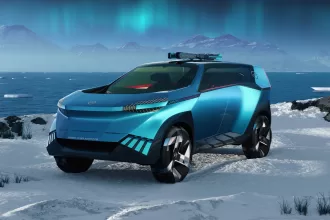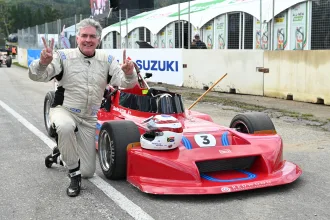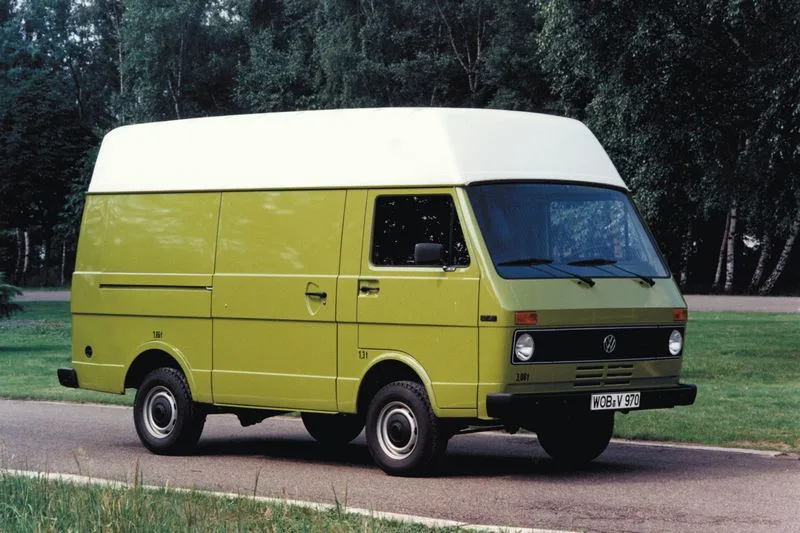- World premiere of the new light cargo transporter (LT) took place in Berlin in April 1975
- A pioneer in ergonomics
- With an outstanding amount of space in a small traffic area, the LT quickly became a bestseller with a market share of up to 40 percent in the segment
- Payload from 1.25 to 3.5 tons (LT 28 to LT 55)
- Perfect base for motorhomes as well
Exactly 50 years ago, the Volkswagen LT was presented in Berlin. The big brother of the VW Bus aka Bulli – which was already in its second generation at the time – successfully expanded the product range from Hanover.
Volkswagen and Transporter: These two terms have been firmly linked since the launch of the Bulli in 1950. However, since the Bulli was not intended for the really large loads, Volkswagen developed a model below the heavy trucks, but above the VW bus, to supplement the product range: a cargo transporter in the 2.8 to 3.5 tonne segment. When it came to the name, the people of Lower Saxony remained cool and objective. So the cargo transporter was simply renamed the model name: LT.
In the appendix, the designations 28, 31 and 35 were found for the maximum permissible weight of 2.8, 3.1 and 3.5 tonnes respectively. As with the Transporter, Volkswagen listened to the wishes of its customers for the LT, and so the LT was available in two wheelbases and two roof variants right from the start. The space-saver was available as a panel van, station wagon, bus, dropside, double cab and as a chassis with cab.

In the run-up to the development, it was decided that the ratio of traffic area to usable area should be even better than for the Transporter with rear engine. To this end, Volkswagen engineers designed a vehicle with the space-saving cab-over-control design of the Transporter and a front-end engine that was placed above the front axle between the driver and front passenger seat. The drive was still provided by the rear axle. Without the engine in the rear, the entire cargo space was thus available for use. And yet the LT remained compact: compared to the T2 Bulli, the LT only grew by 34 cm in length and 30 cm in width. However, due to the new space concept with 7.85 cubic metres of cargo space, it offered more than 50 percent more loading volume.
Volkswagen was also proud of its ergonomics, which had hitherto been rather neglected in commercial vehicles. The cab was developed with the help of ergonomic scientists. Thanks to this cooperation, for example, the controls were arranged close to the driver and a large windscreen and extra-large exterior mirrors were installed.

Among other things, an extra ride comfort was provided by individual wheel suspension on the front axle, which was still not standard in the segment many years after the introduction of the LT. Initially, the Volkswagen was available with a choice of a 2.0-litre four-cylinder petrol engine from the Audi 100 (throttled down to 55 kW/75 hp and adapted to operation in a commercial vehicle) or a 2.7-litre four-cylinder diesel engine from the English manufacturer Perkins with 48 kW (65 hp).
Volkswagen replaced it in 1979 with its first own six-cylinder diesel engine. Although the new 2.4-litre engine produced only eight hp more in the LT than its predecessor, it developed significantly more torque and ran extremely smoothly – so quietly that even Volvo installed this engine in their first six-cylinder passenger car.

Like the Bulli, the LT has received numerous facelifts over the years. Here is an excerpt:
1983:
• Six-cylinder turbo diesel with 75 kW (102 hp). As a result, the LT had grown to become the most powerful transporter in Europe.
• Six-cylinder petrol engine with 66 kW (90 hp)
• Optimised installation position of the engine provides space for a third seat in the cab
• Redesigned dashboard.
• Third wheelbase for dropbeds up to 4.6 metres in length available
1985:
• LT 55 with 5.6 tonnes gross vehicle weight
• LT 35 optionally with rear axle with single tyres
• Switchable all-wheel drive 4×4
• Facelift with rectangular headlights instead of the previous circular
1993:
• Facelift with new radiator grille and plastic elements in the area of the tail lights
• Revised turbo diesel with intercooler and 70 kW (95 hp)
Due to its quality and reliability, coupled with the large usable area with compact dimensions, the LT also quickly became a popular base for motorhomes. Even today, a large number of them are on the roads of the world. So it came as no surprise to anyone in 1988 that, in addition to the compact California based on the third-generation (T3) of the Bulli, Volkswagen also presented a motorhome based on the LT: With the Florida, Volkswagen offered a fully equipped motorhome for four people with a wet cell.
After 21 years and more than 470,000 LT vehicles produced, the time was ripe for a successor in 1996.
1996: The second generation of the LT
After 21 years, the era of the compact and popular load transporter came to an end in 1996. As with the change from the T3 to the T4, the change from the LT1 to the LT2 was also a change into a more modern age. The LT2 was the first new vehicle to be introduced by the newly founded Volkswagen Commercial Vehicles (VWN) brand in Hanover, which was founded in 1995. The development of this and the subsequent model series was carried out in cooperation with Mercedes-Benz.
The diesel engines were now installed lengthwise under a short bonnet. The entry was much lower, and it was possible to easily reach the rear of the load and passenger compartment between the front seats.
Volkswagen’s recipe for success of offering customers a wide range of products has also been retained in the LT2. There were also panel vans, station wagons, buses, dropsides, double cabs and chassis with three wheelbases and a gross vehicle weight of between 2.6 and 4.6 tonnes.
Another advantage was the popular TDI engines: they were also the first choice in the LT2 because they were economical, powerful and reliable. In 2002, VWN turned the LT2 into an “express” vehicle with a new 2.8-litre four-cylinder diesel engine. The engine had 116 kW (158 hp) and a maximum torque of 331 Nm. These were record figures in the segment.
Production at the Stöcken plant ended in 2006 after almost 340,000 vehicles.
2006: The Crafter
Based on the basic concept of its predecessor, the Crafter was launched on the market in 2006 – visually in truck design and technically a completely new vehicle. This was also made clear by the new name: Crafter stood and still stands for a dynamic helper in everyday work, for “someone who lends a hand”.
The most spectacular variant to date was certainly the Crafter 4MOTION with Achleitner all-wheel drive presented in 2012. In its full configuration, the vehicle was equipped with up to three locks, raised and had off-road tires as well as a complete underride guard. The Crafter 4MOTION was able to demonstrate its qualities as a support vehicle at the 2012 Rallye Dakar.
For ten years, the Crafter was again produced in a wide variety of variants (panel van, station wagon, bus, dropside, double cab and chassis). More than 480,000 units sold speak for the success of this third generation.
2016: The new Crafter – 100 % Crafter – 100 percent VWN
In 2016, Volkswagen Commercial Vehicles unveiled the second-generation Crafter for the first time. It is a vehicle developed from scratch and again in-house, for which a new plant was even built in Września, Poland.
During the development process, the experts at Volkswagen Commercial Vehicles asked customers more intensively than ever before about their needs and ideas. And they were also invited to play an active role in shaping the new Crafter according to their ideas. Specialists from Hanover often accompanied the drivers in their everyday lives and asked them about their wishes directly at their workplace.
The result is probably the best and most diverse vehicle in the C/D segment of light commercial vehicles. In addition to the various bodies, the Crafter was now also available for the first time with front, rear or all-wheel drive. Thanks to its passenger car handling and an unprecedented range of safety and driver assistance systems, the new Crafter has become the benchmark in the Segment. A gross vehicle weight of up to 5.5 tonnes, a loading volume of up to 18.4 m3 and an outstanding variety of drives and derivatives offer customer-oriented functionality and solutions suitable for everyday use for individual transport tasks from all areas of use.
The international jury of commercial vehicle journalists from 24 European countries awarded the Crafter the title of “Transporter of the Year 2017” as soon as it was launched on its market.
One year later, VWN presented the electrically powered ‘e-Crafter’ variant and the ‘Grand California’ motorhome as an extension of the Crafter product range.
2024: The new Crafter – more safety, more comfort, the same price level
The new Crafter is available as standard with digital instruments: the so-called ‘Digital Cockpit’. The defining interior detail of the 2024 Crafter is its now 10.3-inch and optionally 12.9-inch display based on the latest ‘Modular Infotainment Toolkit’ (MIB). The visually free-standing VW system features a newly developed graphical user interface and a self-explanatory menu navigation. In addition, the Crafter received a new online voice control system for numerous vehicle functions with “ChatGPT” integration, which responds to natural voice commands.
The handbrake and the switch of the automatic gearbox have been redesigned, as well as the controls for the light functions, the buttons in the area of the center console and all air vents. Take the handbrake, for example: it is now an electronic parking brake, operable via a switch in the cockpit, and the previous lever between the front seats is no longer required.
The range of new standard and optional assistance systems takes the successful Crafter series to a new level. In future, the following systems will be part of the standard equipment of all new Crafters: ‘Front Assist’ (emergency braking assistant including cyclist and pedestrian detection), ‘Lane Assist’ (lane departure warning), traffic sign recognition, a speed limiter and an acoustic parking aid for the rear area. For the first time, ‘Travel Assist’ will be available as an option for the Crafter; In combination with it, ‘Emergency Assist’ also finds its way into the Crafter.
Despite more extensive safety equipment and more comfort features that make everyday working life in the new Crafter easier, the prices are on a par with the predecessor model.
By the end of 2024, almost 500,000 units of the new Crafter had already been produced.









